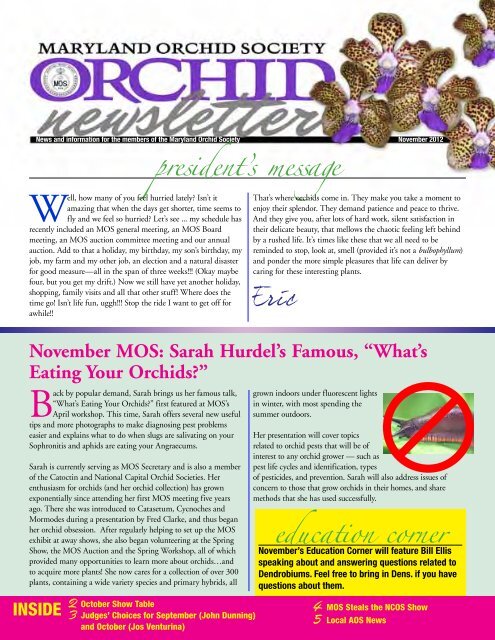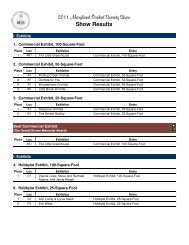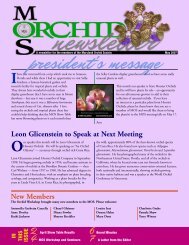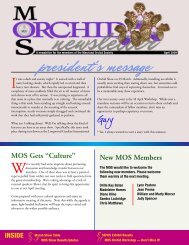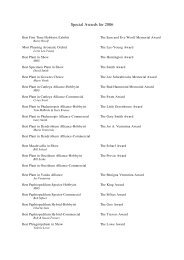November 2012 - Maryland Orchid Society
November 2012 - Maryland Orchid Society
November 2012 - Maryland Orchid Society
You also want an ePaper? Increase the reach of your titles
YUMPU automatically turns print PDFs into web optimized ePapers that Google loves.
News and information for the members of the <strong>Maryland</strong> <strong>Orchid</strong> <strong>Society</strong> <strong>November</strong> <strong>2012</strong><br />
president̕ s message<br />
Well, how many of you feel hurried lately? Isn’t it<br />
amazing that when the days get shorter, time seems to<br />
fly and we feel so hurried? Let’s see ... my schedule has<br />
recently included an MOS general meeting, an MOS Board<br />
meeting, an MOS auction committee meeting and our annual<br />
auction. Add to that a holiday, my birthday, my son’s birthday, my<br />
job, my farm and my other job, an election and a natural disaster<br />
for good measure—all in the span of three weeks!!! (Okay maybe<br />
four, but you get my drift.) Now we still have yet another holiday,<br />
shopping, family visits and all that other stuff! Where does the<br />
time go! Isn’t life fun, uggh!!! Stop the ride I want to get off for<br />
awhile!!<br />
That’s where orchids come in. They make you take a moment to<br />
enjoy their splendor. They demand patience and peace to thrive.<br />
And they give you, after lots of hard work, silent satisfaction in<br />
their delicate beauty, that mellows the chaotic feeling left behind<br />
by a rushed life. It’s times like these that we all need to be<br />
reminded to stop, look at, smell (provided it’s not a bulbophyllum)<br />
and ponder the more simple pleasures that life can deliver by<br />
caring for these interesting plants.<br />
Eric<br />
<strong>November</strong> MOS: Sarah Hurdel’s Famous, “What’s<br />
Eating Your <strong>Orchid</strong>s?”<br />
Back by popular demand, Sarah brings us her famous talk,<br />
“What’s Eating Your <strong>Orchid</strong>s?” first featured at MOS’s<br />
April workshop. This time, Sarah offers several new useful<br />
tips and more photographs to make diagnosing pest problems<br />
easier and explains what to do when slugs are salivating on your<br />
Sophronitis and aphids are eating your Angraecums.<br />
Sarah is currently serving as MOS Secretary and is also a member<br />
of the Catoctin and National Capital <strong>Orchid</strong> Societies. Her<br />
enthusiasm for orchids (and her orchid collection) has grown<br />
exponentially since attending her first MOS meeting five years<br />
ago. There she was introduced to Catasetum, Cycnoches and<br />
Mormodes during a presentation by Fred Clarke, and thus began<br />
her orchid obsession. After regularly helping to set up the MOS<br />
exhibit at away shows, she also began volunteering at the Spring<br />
Show, the MOS Auction and the Spring Workshop, all of which<br />
provided many opportunities to learn more about orchids…and<br />
to acquire more plants! She now cares for a collection of over 300<br />
plants, containing a wide variety species and primary hybrids, all<br />
grown indoors under fluorescent lights<br />
in winter, with most spending the<br />
summer outdoors.<br />
Her presentation will cover topics<br />
related to orchid pests that will be of<br />
interest to any orchid grower — such as<br />
pest life cycles and identification, types<br />
of pesticides, and prevention. Sarah will also address issues of<br />
concern to those that grow orchids in their homes, and share<br />
methods that she has used successfully.<br />
education corner<br />
<strong>November</strong>’s Education Corner will feature Bill Ellis<br />
speaking about and answering questions related to<br />
Dendrobiums. Feel free to bring in Dens. if you have<br />
questions about them.<br />
InSide<br />
2 October Show Table<br />
3 Judges’ Choices for September (John Dunning)<br />
and October (Jos Venturina)<br />
4 MOS Steals the NCOS Show<br />
5 Local AOS News
october <strong>2012</strong> show table winners by Tom McBride<br />
Special thanks to Sarah Hurdel for the beautiful photos below of last month’s show table plants!<br />
Novice<br />
1. Phal. Hybrid<br />
(left) - Amanda<br />
Gallegos<br />
2. Hwra. Lava<br />
Burst ‘Puinani’<br />
AM/AOS - The<br />
Hallameyers<br />
Home Grown<br />
1. Enc. cochleata - John Dunning<br />
2. Tie Paph. Ho Chi Minh - Owen<br />
Humphrey<br />
Hab. rhodochila ‘Nuanna’ FCC/<br />
AOS (above)- Chris Zajac<br />
3. Tie Slc. Fuchsia Doll - Deborah Dade<br />
Cirr. Elizabeth Ann ‘Buckelberry’<br />
FCC/AOS - The Soykes<br />
Greenhouse<br />
1. Masd. Aquarius - Jos Venturina<br />
2. Stenoglottis longifolia - David Smith<br />
3. Lc. Chocolate Drop X B. nodosa -<br />
Barbara Buck<br />
Cattleya<br />
1. Cattleya Hybrid (above)-<br />
Craig Taborsky<br />
2. Tie Blc. Hawaiian Stars ‘Hsinying’ -<br />
John Dunning<br />
Sc. Calypso ‘Crestwood’ HCC/<br />
AOS - David Smith<br />
3. C. Caudebec ‘Carmela’ HCC/AOS -<br />
Robert Johnston<br />
Phalaenopsis<br />
1. Phal. Coral Star (above) -<br />
John Dunning<br />
2. Phal. Sheena Beauty ‘Ran Ran’ -<br />
Judi von Mehlem<br />
3. Phal. Memphis Music ‘Mem. Olivia’<br />
AM/AOS - The Lundys<br />
Oncidium<br />
1. Milt. Earl Dunn ‘Dark Lip’ - Robert<br />
Johnston<br />
2. Tie Burr. Nelly Isler ‘Swiss Beauty’<br />
(above)- Janice Mazur<br />
Onc. taochicum - David Smith<br />
3. Tie Alcra. Hilo Ablaze ‘Hilo Gold’<br />
HCC/AOS - John Dunning<br />
Onc. (Nonamyre X onustum) -<br />
Chris Zajac<br />
Psy. (Mendenhall X papilio) -<br />
Mary Chiu<br />
Paphiopedilum and Phragmipedium<br />
1. Paph. barbigerum f. album -<br />
Clark Riley<br />
2. Paph. Pinocchio - The Dagostins<br />
3. Paph. (tonsun X henryanum) -<br />
John Dunning<br />
Dendrobium<br />
1. Den. Mingle’s Sapphire - David Smith<br />
2. Den. Enobi Purple ‘Purple’ -<br />
John Dunning<br />
3. Den. Darlin Imp ‘Sentinel’s Pink<br />
Showers’ - The Dagostins<br />
2<br />
Miscellaneous<br />
Hybrids<br />
1. V. Robert’s<br />
Delight (left)<br />
-Jos Venturina<br />
2. Cyd. Wine<br />
Delight ‘JEM’<br />
FCC/AOS -<br />
John Dunning<br />
3. Bulb. (dearei X echnolabium)<br />
- Sue Spicer<br />
Species<br />
1. Gram. scriptum var. citrinum -<br />
John Dunning<br />
2. Ceratostylis rubra - David Smith<br />
3. Ceratostylis rubra - Bill Scharf<br />
Miniature<br />
1. Neolehmannia porpax - David Smith<br />
2. Den. rigidum - Sue Spicer<br />
3. Masd. herradurae - Bill Scharf<br />
First Bloom Seedling<br />
1. Paph. Wossner Vietnam Love<br />
(above)- Janice Mazur<br />
2. Paph. (Hsinying Magic Voodoo X<br />
charlesworthii) - John Dunning<br />
Fragrance<br />
1. C. labiata var. suave - Craig Taborsky<br />
2. Lc. Cariad’s Mini-Quinee -<br />
The Lundys<br />
The Judges Choice of the Evening<br />
was Masd. Aquarius, exhibited by Jos<br />
Venturina. See December’s newsletter<br />
for Jos’ description of how he grows<br />
this beautiful orchid. The judges were<br />
Judi von Mehlem, Ernie Drohan and<br />
Ann Lundy. There were an incredible 84<br />
beautiful plants displayed on our show<br />
table this month.
september judges’ choice<br />
Growing Gram. Scriptum <strong>Orchid</strong>s By John Dunning<br />
In Nature, Gram. scriptum plants grow<br />
at low altitudes under hot steamy<br />
conditions in the coastal forests of the<br />
larger tropical Pacific islands, including<br />
the Philippines, the Moluccas, the<br />
Solomon Islands, Figi and New Guinea.<br />
With much heavy watering, rich in<br />
phosphate fertilizer, in the early spring, its<br />
leaves grow up from the base of old<br />
pseudobulbs to about 1 to 2 feet high.<br />
Around the 1st of May, I put the plants<br />
outside under a 50% shade canopy to<br />
shield them from sun directly overhead<br />
(like with Vandas). G. scriptum likes full<br />
morning and afternoon sun but leaves can<br />
burn from long exposure to bright<br />
unshielded hot sun directly overhead.<br />
With the first hot humid days of June,<br />
spikes begin to form at the base of<br />
Photo by Sarah Hurdel<br />
pseudobulbs which best grow together in<br />
clumps inside 4 to 8 inch pots. They<br />
LOVE the hot steamy Baltimore summer<br />
weather (95 to 105 degrees) such as what<br />
we had this past summer! In early July<br />
spikes grow up quickly to be about 20 to<br />
40 inches long containing up to 100 buds<br />
each, which begin to flower in early<br />
August. The two-inch across non-fragrant<br />
flowers typically stay in bloom for 1 to 2<br />
months. I soak my G. scriptum pots for<br />
about 15 minutes in water 2 or 3 times a<br />
week from early spring thru early fall and<br />
about once a week in the winter. I soak in<br />
full strength high phosphate fertilizer from<br />
about the first of March thru July and<br />
switch to about 25% strength high<br />
nitrogen fertilizer for the rest of the year.<br />
Without help from rainstorms, I flush<br />
with pure water once every two weeks.<br />
Leaves typically last less than two years,<br />
leaving bare pseudobulbs in clumps, which<br />
may be separated, and those with roots<br />
repotted to 4 inch pots.<br />
How I Grow My Vanda Robert’s Delight<br />
(Parents: Vanda Kasem’s Delight x Vanda Madame Rattana)<br />
By Jos Venturina<br />
Jos’ beautiful Vanda won first place in this past month’s Miscellaneous Hybrids class. Following is an excerpt of how Jos grows his Vanda.<br />
Vanda Robert’s Delight, a meristem,<br />
is recognized for its eye-catching,<br />
huge, rounded flowers, and deep<br />
maroon coloration. It possesses leathery,<br />
drought-resistant leaves. I purchased my<br />
plant from an orchid nursery in Florida; it<br />
was in bloom at that time. I’ve had this<br />
plant for more than 5 years.<br />
This plant is growing in a plastic basket,<br />
with its bare roots requiring daily watering<br />
and weekly feeding during the active<br />
growing season. This plant needs very<br />
high light levels to bloom. It spends the<br />
summer outside the greenhouse, under<br />
aluminum cloth to get 50% sunlight.<br />
When the ambient temperature reaches<br />
around 80 degrees (maximum), I expose<br />
the plant to direct sunlight. This plant<br />
puts out one to two flower spikes every<br />
year (two this year) between late summer<br />
and early fall.<br />
Before the winter weather sets in, I move<br />
this plant back to the greenhouse, reduce<br />
watering and stop the fertilizer.<br />
Photo by Sarah Hurdel<br />
3
Mos Steals the Ncos Show!!<br />
Thanks to the gracious loan of plants from Steve and Rachael Adams, Frank Dagostin, John Dunning, Suzanne Gaertner, J. Hildebrandt, Sarah<br />
Hurdel, Marilyn Lauffer, Valerie Lowe, Ann Lundy, Norma Lynch, Janice Mazur, Michael Moran, Jamie Riegel, Clark Riley, Mark Robbins, David<br />
Smith, Gary Smith, Bill Soyke, Tammi Staub, Eric Wiles, Barry Woolf, Chris Zajac and The Little Greenhouse, the <strong>Maryland</strong> <strong>Orchid</strong> <strong>Society</strong> was<br />
awarded the <strong>Orchid</strong> Digest Award for Best Amateur Exhibit in Show and the American <strong>Orchid</strong> <strong>Society</strong> Trophy for Best Exhibit in Show. Many<br />
thanks to Sarah Hurdel, David Smith, Margaret Smith, Gary Smith, Tammi Staub and Eric Wiles for helping me to install the exhibit and to Sarah<br />
Hurdel, Owen Humphrey and Gary Smith for helping me take the exhibit down.……………..Valerie Lowe<br />
Ribbon<br />
Owner<br />
Ribbon<br />
Owner<br />
First Place Ribbons<br />
Angraecum distichum<br />
D. Smith<br />
Btcm. Little Dragon’Carmela’, HCC/AOS D. Smith<br />
Angraecum distichum<br />
D. Smith<br />
Blc Dennis Kone ‘Ruby Red’<br />
J. Dunning<br />
Paph. W.A. Sutton ‘Patty’, AM/AOS M. Robbins<br />
Epi. difforme<br />
The Little Greenhouse<br />
Den. laevifolium<br />
The Little Greenhouse<br />
Coch. amazonica ‘Loch Raven’, HCC/AOS The Little Greenhouse<br />
C. Spotted Gem ‘Snow Leopard J. Hildebrand<br />
C. maxima S. & R. Adams<br />
Second Place Ribbons<br />
Epi. diffusum<br />
D. Smith<br />
Milt. spectabilis v mooreliana<br />
‘Anne Warne’, AM/AOS<br />
D. Smith<br />
Oecl. roseo-varigata<br />
D. Smith<br />
C. Mini-Purple ‘Tamiami’ E. Wiles<br />
Gram. scriptum v. citrinum #2<br />
J. Dunning<br />
Colm. Massai Red<br />
J. Gaertner<br />
L. lucasiana S. & R. Adams<br />
Paph. Wossner Koloniv<br />
S. & R. Adams<br />
Den. Stephen Batchelor<br />
S. & R. Adams<br />
Aer. lawrenceana<br />
S. & R. Adams<br />
Hab. medusae<br />
V. Lowe<br />
Phrag. Belle Hougue Point<br />
W. Soyke<br />
Phrag. Giganteum<br />
W. Soyke<br />
Alcr. Hilo Ablaze ‘Hilo Gold’, HCC/AOS W. Soyke<br />
Phrag. Demetria<br />
B. Woolf<br />
Third Place Ribbons<br />
Phrag. Noirmont ‘Clemencia’<br />
Onc. Jiubao Gold ‘Tianan’<br />
Hasgw. Red Stella ‘Hawaii’, AM/AOS<br />
C. Zajac<br />
A. Lundy<br />
D. Smith<br />
Third Place Ribbons continued<br />
Alcra. Pacific Treasures ‘Everything Nice’ D. Smith<br />
Pleur. denticulata<br />
D. Smith<br />
Liparis condylobulbon<br />
D. Smith<br />
Eria densa<br />
E. Wiles<br />
L. lucasiana x C. loddigesii E. Wiles<br />
Hwra. Lava Burst ‘Puananii’, AM/AOS F. Dagostin<br />
Paph. Hilo Green Mountain<br />
The Little Greenhouse<br />
Paph (Hilo Magic Shift x Hilo Ruby) S. Hurdel<br />
Odcdm. Wildcat ‘Bobcat’<br />
S. Hurdel<br />
Paph. primulum v. purpurescens<br />
V. Lowe<br />
Bulb. Wilbur Chang<br />
W. Soyke<br />
Honorable Mention<br />
Phal. Ever-Spring Light<br />
Phal. hybrid<br />
Best Miniature Plant in Show<br />
Angraecum distichum (right)<br />
Best Amateur-grown Miniature Plant<br />
Angraecum distichum<br />
Best Amateur-grown Vandaceous Alliance<br />
Angraecum distichum<br />
Best Amateur-grown Species Plant<br />
Angraecum distichum<br />
Best <strong>Society</strong> Exhibit<br />
Best Exhibit in Show<br />
J. Dunning<br />
S. Hurdel<br />
D. Smith<br />
D. Smith<br />
D. Smith<br />
D. Smith<br />
The <strong>Maryland</strong> <strong>Orchid</strong> <strong>Society</strong><br />
The <strong>Maryland</strong> <strong>Orchid</strong> <strong>Society</strong><br />
Sarah Hurdel installed a small exhibit at the NCOS Show and garnered The<br />
Slotter Award (Best Amateur Exhibit – Less Than 25 Square-Foot), a $25<br />
endowed award!<br />
4<br />
Photos by B. J. Ramsay
The <strong>Maryland</strong> <strong>Orchid</strong> <strong>Society</strong> Wins at SOS Again!!!!<br />
Thanks to the untiring efforts of Sarah Hurdel, Jamie Riegel, Bill Scharf, Gary Smith, Sue Spicer, Bob Travers, and Eric Wiles with the generous<br />
donation of plants by Steve and Rachel Adams, Frank Dagostin, John Dunning, Suzanne Gaertner, Jenny Hildebrand, Owen Humphrey, Sarah Hurdel,<br />
Marilyn Lauffer, Valerie Lowe, Ann Lundy, Norma Lynch, Janice Mazur, Michael Moran, Jamie Riegel, Bill Scharf, David Smith, Gary Smith, Bill<br />
Soyke, Sue Spicer, Tami Staub, Eric Wiles, Chris Zajac, and The Little Greenhouse, the <strong>Maryland</strong> <strong>Orchid</strong> <strong>Society</strong> Away Shows Committee installed<br />
another award winning exhibit at the Susquehanna <strong>Orchid</strong> <strong>Society</strong> Show. The 50 sq. ft. exhibit was voted the Best <strong>Society</strong> Exhibit in the Show and<br />
also received the <strong>Orchid</strong> Digest Award for the Best Amateur Exhibit in the Show and the American <strong>Orchid</strong> <strong>Society</strong> (AOS) Show Trophy for the Best<br />
Exhibit in the Show. (See page 6 for a photo of the display.) Although several plants were pulled from the exhibit for consideration for AOS flower<br />
and cultural awards, none of these were granted at this time. However, other ribbons and awards were granted as follows:<br />
Plant Place Owner<br />
Dendrobium Stephen Batchelor 1 st S. and R. Adams<br />
Neof. Lou Sneary 3 rd “<br />
Paph. Doll’s Kobold 2 nd “<br />
V. Robert’s Delight ‘Torblue’ 1 st “<br />
Bpl. Golden Peacock ‘Orange Beauty’ 1 st J. Dunning<br />
Phal. Ever-Spring Light 1 st “<br />
Paph. Heron’s Faire 3 rd “<br />
Paph. tonsum 3 rd O. Humphrey<br />
L. dayana v coerulea 2 nd S. Hurdel<br />
Ludisia discolor v alba 1 st “<br />
Ludisia discolor 2 nd “<br />
Paph. venustum 3 rd “<br />
Paph. Monsoon Temptation 1 st “<br />
Paph. hirsutissimum 2 nd G. Smith<br />
Paph. Curtis Lutchman 1 st G. Smith<br />
Phal. Nobby’s Amy 2 nd G. Smith<br />
Phal. hybrid 3 rd S. Hurdel<br />
Phrag. schlimii 2 nd S. Hurdel<br />
Ludisia discolor ‘Ambrosia’, CHM, AOS 3 rd V. Lowe<br />
Paph. chamberlainianum v. latifolium 2 nd “<br />
Bulb. medusae 3 rd A. Lundy<br />
Paph. barbigerum 1 st BEST “<br />
Pyp. Mendenhall ‘Monarch’, AM/AOS 1 st “<br />
C. Bob Betts ‘White Lightning’ 2 nd N. Lynch<br />
Onc. Sunlight ‘Hilo Honey’ 3 rd J. Mazur<br />
Paph. Memoria D. Anne Lowe 2 nd “<br />
Paph. Henrietta Fujiwara 1 st BEST M. Moran<br />
Phal. cornu-cervi ‘Linda’, HCC/AOS 2 nd “<br />
Phal. hybrid 2 nd J. Riegel<br />
Dendrobium oligophyllum 3 rd W. Scharf<br />
Masd. herradurae v. xanthina 1 st “<br />
Slc (Ken’s Dream x Tokyo Magic) 3 rd “<br />
Liparis condylobulbon 3 rd D. Smith<br />
Bulb. Wilbur Chang 1 st W. Soyke<br />
Holcoglossum wangii 1 st S. Spicer<br />
Phrag. pearcei 3 rd “<br />
Alcra Hilo Ablaze ‘Hilo Gold’, AM/AOS 3 rd E. Wiles<br />
Ceratostylis rubra 1 st “<br />
Epi. hybrid 2 nd “<br />
Pleuro. allenii 1 st “<br />
Epi. cochleata 3 rd C. Zajac<br />
C. Portia ‘Cannizaro’, FCC/AOS 1 st The Little Greenhouse<br />
Chondrorhynca (Molier x albicans) 1 st “<br />
Dendrobium laevifolium #1 1 st BEST “<br />
Dendrobium laevifolium #2 3 rd “<br />
Dendrobium Mingle’s Sapphire 2 nd “<br />
Dockrilla rigida 2 nd “<br />
Paph. Hilo Green Mountain 1 st “<br />
The exhibit was dismantled and all packed up within an hour with the help of Sarah Hurdel, Bill Scharf and Sue Spicer.<br />
Submitted by Valerie Lowe, Away Shows Chair<br />
5
Photo by Sarah Hurdel<br />
Another award-winning exhibit at the Susquehanna <strong>Orchid</strong> <strong>Society</strong> Show<br />
The 50 sq. ft. exhibit was voted the Best <strong>Society</strong> Exhibit in the Show and also received the <strong>Orchid</strong><br />
Digest Award for the Best Amateur Exhibit in the Show and the American <strong>Orchid</strong> <strong>Society</strong> (AOS)<br />
Show Trophy for the Best Exhibit in the Show. (Photo by Valerie Lowe)<br />
aos corner<br />
Lynn Fuller, Chair, AOS Affiliated Societies Committee<br />
local aos news<br />
Novmber 3: National Capital Judging<br />
Center:<br />
Sarah Hurdel’s plant of Holcoglossum<br />
wangii ‘Sweetheart’ received a 79 point<br />
Highly Commended Certificate (HCC).<br />
The 2013 AOS conservation<br />
calendars are available.<br />
Photographs are of orchids in their<br />
natural habitat. This large 11x22”, fullcolor<br />
calendar contains 14 months so you<br />
can keep dates into 2014. Enjoy the<br />
beauty of orchids in the wild as you<br />
support conservation, with $2 of each<br />
calendar purchase going to fund AOS<br />
conservation projects. Wholesale pricing<br />
for groups are packed and available in<br />
boxes of 12). They make great holiday<br />
gifts for your orchid loving friends and<br />
family!<br />
Gordon W. Dillon - Richard C.<br />
Peterson Memorial Essay Contest. The<br />
deadline for submissions to his annual contest<br />
is <strong>November</strong> 30, <strong>2012</strong>. The theme for<br />
the <strong>2012</strong> essay is: The <strong>Orchid</strong>s I Want But<br />
Can’t Really Find (Real or Imagined).<br />
More information on essay submissions<br />
and rules may be found on the AOS website.<br />
A bit of history on the award (from<br />
the AOS website): The contest was established<br />
in 1985 by the AOS Northeast<br />
Judging Center to honor the memory of<br />
two former editors of the AOS Bulletin<br />
(now <strong>Orchid</strong>s). Gordon Dillon served as<br />
editor from 1943 through 1968 and again<br />
from 1970 through 1973. Richard<br />
Peterson’s name first appeared on the masthead<br />
of the AOS Bulletin in April 1971 as<br />
associate editor. In 1973, he was named<br />
editor and, upon Dillon’s retirement in<br />
1977, he became the executive director,<br />
retaining his position of editor through<br />
1984.<br />
The Chair of the Publications Committee<br />
recently updated the society newsletter<br />
resources page on the AOS website.<br />
Included in this resource are ideas for society<br />
newsletter contents as well as a template<br />
for creating a newsletter, professional photographs<br />
to use and clip art. Newsletters<br />
are a great way to keep the lines of communication<br />
open among your society<br />
members. If your society doesn’t have one<br />
yet, check out the page under the Affiliated<br />
Societies tab for this resource. Most societies<br />
post their newsletters on their website<br />
and they are available to read by anyone<br />
from their website.<br />
Next month I will give a report of the<br />
Members Meeting this month in Portland,<br />
Oregon.<br />
6<br />
Prepare to Partay<br />
Mark your calendars, save the date!<br />
The MOS holiday party is just around<br />
the corner. Always a wild time, the<br />
party on December 20 will be kicked<br />
up a notch as Eric Wiles will again<br />
wear his mistletoe hat. Consider<br />
bringing a covered dish (of food) or<br />
some other food-related consumable<br />
to the party. If you’d like to contribute<br />
to the holiday party, contact<br />
Barbara Buck at 410-551-9374 or<br />
barbarabuck@comcast.net. Also,<br />
don’t forget to pick up<br />
your <strong>2012</strong> - 2013 Member<br />
Roster at the meeting.
To Grow an <strong>Orchid</strong>, it Takes a Village, ... and Some<br />
Fungus<br />
An orchid bloom, so delicate and<br />
elegant, arises out of a complex<br />
symbiotic relationship with, of all<br />
things, fungi. It’s a classic case of beauty<br />
and the beast, or gorgeous meets gross. But<br />
the fundamental relationship between the<br />
much-admired botanical family known as<br />
the <strong>Orchid</strong>aceae, which make up more<br />
than ten percent of the world’s plants, and<br />
the little-understood fungi that live in the<br />
soils of a forest floor, is one of the more<br />
complex mysteries being studied by<br />
Smithsonian orchid ecologists. And as<br />
more and more orchid species disappear<br />
from North American forests, botanist<br />
Dennis Whigham of the Smithsonian<br />
Environmental Research Center in<br />
Edgewater, <strong>Maryland</strong>, says it’s another<br />
example of the canary in the coal mine, a<br />
warning that must be heeded. “When<br />
orchids are present,” Whigham says, “that<br />
means the ecosystem is in good shape.”<br />
At the Smithsonian’s greenhouses, orchid expert Tom Mirenda tells tales about a few of the<br />
beauties growing there, including from left to right: Aliceara Pacific Nova—“A weird and twisted<br />
hybrid made from a combination of several orchid genera.” Brassidium Fangtastic Bob Henley—<br />
”Looks like it might bite you. But it is perfectly safe…unless you are a wasp. Brassias lure wasps<br />
to their blooms by mimicking the type of spider they parasitize. But this one is just faking ….and<br />
quite disappointing to the wasp who has to keep looking for a ‘real spider.’” Oncidiopsis Stefan<br />
Isler— “<strong>Orchid</strong> hybrids like this combine the best features of their parents. This one combines a<br />
very small red flowered plant with a larger and more floriferous yellow flowered orchid. Such is the<br />
hybridizer’s art.” (Photos by Beth Py-Lieberman)<br />
Recently, to help foster a better understand<br />
of the optimal conditions it takes for native<br />
wild orchids to survive, if not thrive,<br />
Whigham and his colleagues announced<br />
the formation of the North American<br />
<strong>Orchid</strong> Conservation Center, a publicprivate<br />
partnership that includes several<br />
regional botanical gardens as well as the<br />
U.S. Botanic Gardens. The plan is to<br />
establish a national seed bank for the 250<br />
known species of North American orchids<br />
and to identify the genetic diversity of the<br />
fungi that are central to the life-cycle of<br />
each species and figure out how to<br />
propagate them. “There were just a few<br />
people working on conserving native<br />
orchids,” says Whigham, “but now we’ve<br />
created a national network.”<br />
Of Rhyncholaeliocattleya Raye Holmes<br />
‘Newberry,’ or just Cattleya Raye Holmes,<br />
Mirenda says: “This luscious beauty invites<br />
pollinators to visit her with the clear directional<br />
signals of the nectar guides in her lip.”<br />
Above left: Assorted Dendrobium hybrids:<br />
Mirenda says that fall is the best time of<br />
year to see these large hybrid dendrobiums<br />
in full bloom. The Psychopsis Butterfly<br />
at right, he says are “a real orchid<br />
mystery; these fantastic orchids resemble<br />
butterflies, undoubtedly to lure a pollinator,<br />
but in 200 years of cultivation, no one has<br />
ever observed its insect partner in action.”<br />
http://blogs.smithsonianmag.com/<br />
aroundthemall/<strong>2012</strong>/10/to-grow-an-orchidit-takes-a-village-and-some-fungus/<br />
Mirenda (above left) holds a Phalaenopsis flower, to describe what makes an orchid, an orchid.<br />
<strong>Orchid</strong> flowers, he says, “do some pretty awful manipulations to the animals that pollinate them….<br />
here one animal is getting even!” Finally, Mirenda mimics the hard exoskeleton of pollinating bee<br />
with his fingernail.<br />
7
Where’s Daddy? Life With An <strong>Orchid</strong>ist<br />
By Karen and David Hamilton, American <strong>Orchid</strong> <strong>Society</strong> Bulletin, May 1991<br />
Submitted by Norma Lynch, MOS librarian<br />
8<br />
continued on next page
<strong>Orchid</strong>ist continued from page 8<br />
9<br />
continued on next page
<strong>Orchid</strong>ist continued from page 9<br />
<strong>Maryland</strong> <strong>Orchid</strong> <strong>Society</strong> Board<br />
of Trustees Meeting January 24<br />
The next quarterly meeting of the Board will be held at the home of Sarah Spence on<br />
January 24, 2013. Arrive as early as 6:30 PM to enjoy a light meal and refreshments.<br />
(Please consider bringing a side dish or refreshment.) Open to all members. Please<br />
RSVP to Sarah.<br />
Other important dates:<br />
MOS Annual Holiday Party — December 20, <strong>2012</strong><br />
MOS Annual Show and Sale— March 8-10, 2013<br />
SEPOS Show—April 12-14, 2013<br />
New Members<br />
The MOS would like to welcome the following new members:<br />
John B. Carter and Judith Picciotto<br />
maryland orchid society<br />
The MOS Newsletter, published monthly by the<br />
<strong>Maryland</strong> <strong>Orchid</strong> <strong>Society</strong> September through<br />
June, shares the latest news of our orchid<br />
community. Please submit your comments to<br />
sobelman1@verizon.net<br />
We invite articles, notices, etc. for inclusion in<br />
our newsletter. The deadline for inclusion is first<br />
Sunday of the month.<br />
The MOS brings together people interested<br />
in orchids to promote and encourage orchid<br />
culture, preservation, education, propagation,<br />
hybridization, and all other orchid-related<br />
activities of interest to its members. Benefits<br />
of membership include a subscription to the<br />
Newsletter (e-mail and web), voting rights,<br />
borrowing privileges from the MOS Library,<br />
monthly guest speakers, local judging, valuable<br />
door prizes, and much, much, more!<br />
If you are interested in orchid culture and<br />
would like to meet others with similar interests,<br />
we cordially invite you to join the ranks of<br />
<strong>Maryland</strong>ers already enjoying the benefits of<br />
membership in the <strong>Maryland</strong> <strong>Orchid</strong> <strong>Society</strong>.<br />
10<br />
Visit us on the Web at www.marylandorchids.org<br />
<strong>Maryland</strong> <strong>Orchid</strong> <strong>Society</strong><br />
P.O. Box 5651<br />
Baltimore, MD 21210


